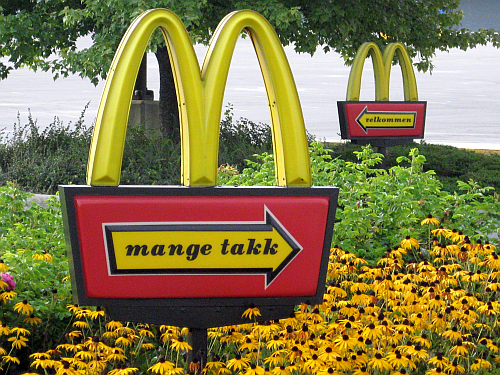Now it looks like we have finally arrived somewhere.
The “somewhere” is Decorah Iowa, home of Luther College and the Vesterheim Norwegian American Museum.
It’s been more than ten years since the last time I was here. They’ve added some nice toy and musical instrument displays, some special exhibitions of contemporary crafts I could do without (although the upcoming Sacred Symbols, Ceremonial Cloth exhibition looks like it could more than make up for it), and they’ve taken away the wonderful basement mishmash of piled up immigrant trunks and random items. That’s how I identified my own immigrant trunk. And where are the calendar sticks? They used to have several examples tucked in the back of a shelf.
There is so much in this museum–it’s hard to choose just two or three things to show. First of all, the museum is a migration story. It’s also my own personal migration story, yes, and one that has been lost to my family as the Norwegian side died young before the stories could be passed on. So it is a sort of a surrogate grandparent.
Migration.
The history of Norway at a gallop:
The migration route:
The first immigrant ship that set sail from Norway on July 4, 1825. Size: 68 feet long by 18 feet wide by 9 feet from keel to deck. Length of journey : 14 weeks. (clickable)
Poem by Norwegian immigrant, written on Norwegian barn.
Goats
The toys here look pretty much like average toys of the era, except for the goats at the very bottom of the shelf.
A closeup of the goat toy shows more detail–two handles that probably can be moved in some way to animate the goats.
For shearing:
A church, complete with outhouse, that was moved on three flatbed trucks from North Dakota through Minneapolis in the middle of the night–I wonder how that went. There were other churches and closer churches that could have been obtained, but they wanted this one. I can see why.
I’m wondering of the style isn’t sort of “Rococo”–Wikipedia doesn’t really cover the movement in the Scandinavian countries, where I think it came later. A bedstead with similar decorative balls is called “Gustavian” on p. 135 of the same The Decorative Arts of Sweden in the above link. (photo is clickable)
Looking closer at the detail of the letter “A” in the alpha and omega design on either side of the altar picture, you can see it is what the same book calls an “Ave Maria monogram” which it says has “a Renaissance character”–is that code for “pre-Reformation”?
Decorah is a nice town– everyone I hung out with in Minneapolis has some family connection to it–but what the town really needs is a place (outside of Nordicfest) where you can get some good Norwegian food.
































September 8, 2009 at 5:02 am
I love those goats. Do you think it was for children to play with?
And that’s a great church. Certainly worth moving through Minneapolis.
One thing about Rococo decoration that distinguishes it from Baroque is that Rococo is (usually) asymmetrical.
September 8, 2009 at 10:36 am
For children to play with? –most definitely. Look at how the goats’ feet are pegged into the handles so they can rotate. I can’t see how the handles are attached to the base though, even though the photo shows more than I could see in person. (Here I’ve uploaded an image with higher resolution, but it doesn’t help much, thanks to shooting through a glass window and the way museums have of not allowing flash, but it does look like the far handle is attached to the base and not the near handle.)
My father has a collection of similar carved wooden toys that do something when you know how to make them move. A complex one is the pecking chickens, but there are simpler ones. http://www.woodworkersworkshop.com/resources/index.php?cat=481&offset=125
September 8, 2009 at 5:06 am
Lucky devils, we don’t get “velkommen” and “mange takk” on our golden arches signs.